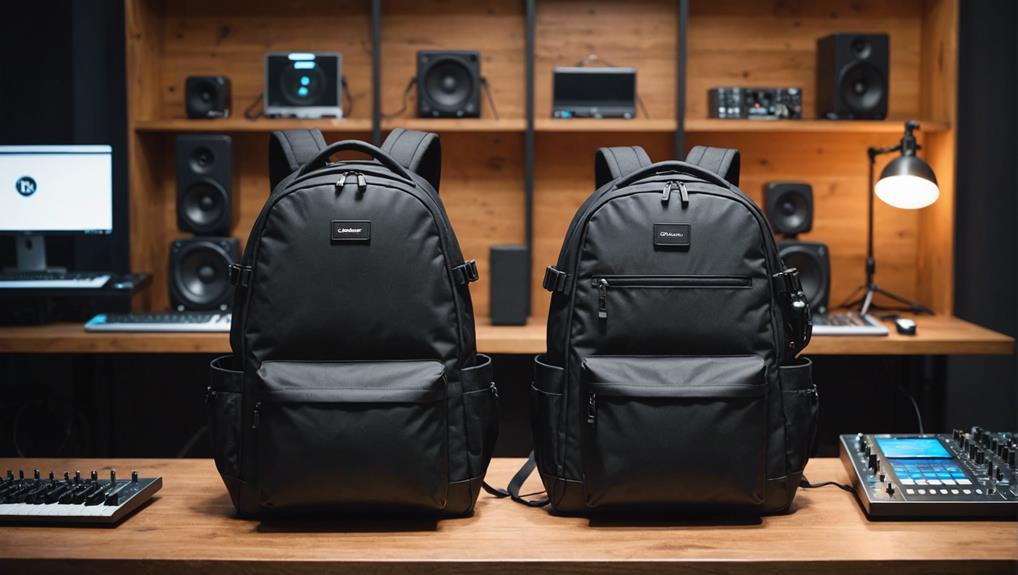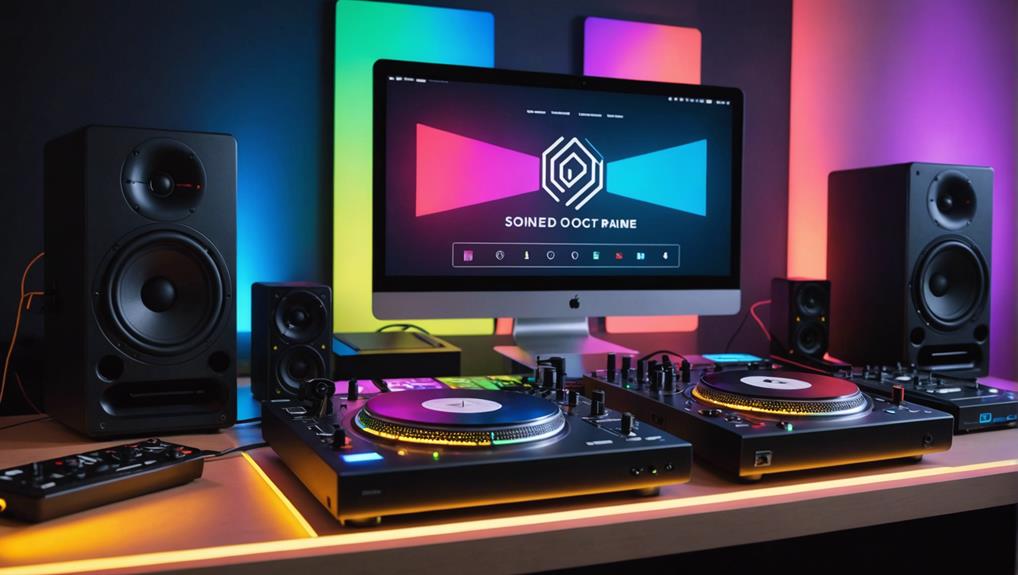No products in the cart.
To master Traktor DJ, start by setting up your TRAKTOR KONTROL S4 and installing the software. Next, tailor your audio settings and troubleshoot any issues for peak performance. Organize your tracks by genre, BPM, and mood, using playlists for efficient access. Familiarize yourself with the interface, mastering basic controls and mixer adjustments. Practice beatmatching and using the sync feature to align tempos seamlessly. Apply DJ effects like reverb and delay to enhance your mixes subtly. Set strategic cue points for dynamic performances. Always adjust EQ for smooth shifts. With persistence, you’ll refine your skills and captivate your audience. There’s more to uncover as you advance.
Key Takeaways
- Install TRAKTOR software and activate it using the provided license key.
- Familiarize yourself with the TRAKTOR interface and basic deck controls.
- Organize your music library by genre, BPM, and key for easy access.
- Practice using sync for beat matching and tempo alignment.
- Experiment with effects like Delay, Reverb, and Filter to enhance your mixes.
Setting Up Traktor DJ
To kick off your DJing journey with Traktor DJ, start by connecting your TRAKTOR KONTROL S4 to your computer using the USB cable for both power and data transfer. Once connected, install the TRAKTOR software and activate it with your license key. This initial equipment setup is important for a smooth performance.
Next, explore the software customization. Open the preferences section in the TRAKTOR software. Here, you’ll set up your audio settings. Make sure your output is correctly configured to route through your speakers or headphones. This step is essential to avoid any embarrassing silent moments during your set!
Now, it’s time to configure your TRAKTOR KONTROL S4 within the software. This ensures all knobs, faders, and jog wheels are fully functional. Don’t skip the calibration of your jog wheels and faders. Accurate and responsive controls are key to flawless mixing and scratching.
If you encounter any issues during these steps, don’t panic. Troubleshooting is part of the process. Check your connections, restart the software, or revisit your settings. Remember, a well-set-up system leads to stellar performances. Keep adjusting until you get it right!
Organizing Your Music Library
As a DJ, organizing your music library in Traktor is essential for seamless performances. You’ll want to categorize tracks effectively, use playlists strategically, and regularly update your track metadata to guarantee quick access and ideal mix flow.
These steps not only save you time during live sets but also enhance your ability to deliver a dynamic musical experience.
Categorize Tracks Effectively
Effectively categorizing your tracks in Traktor by genre, BPM, key, and mood guarantees you can quickly access the right music for any set.
Start by using Traktor’s advanced genre classification to group your tracks. This makes it easier to set the tone for any part of your performance.
Next, engage in BPM analysis to align tracks that match the energy levels you need.
Implementing key detection is essential; it ensures smooth connections by matching complementary keys.
Also, don’t overlook mood assignment, which helps you evoke the right emotions at the right time.
Utilize Playlists Strategically
Now that you’ve categorized your tracks, strategically utilizing playlists will streamline your access to the perfect music for any set. Mastering playlist management and music organization in Traktor DJ is vital for a flawless performance.
Here are some tips to enhance your playlist strategies:
- Create dynamic playlists based on genres, moods, or events, ensuring you’re always ready, regardless of the gig.
- Implement color-coding or tagging to quickly navigate your library and find what you need at a glance.
- Arrange playlists logically, facilitating smooth shifts and cohesive mixes that keep the dance floor energized.
Update Metadata Regularly
Why should you regularly update the metadata in your Traktor DJ music library?
Metadata management is important for maintaining an organized, accessible music collection. By regularly updating artist names, titles, genres, and BPMs, you’ll make sure your tracks are correctly categorized, making them easier to locate during a live set.
Adopt these best practices: use Traktor’s tools to batch edit metadata, which saves time and promotes consistency. Always check for duplicates, merging or removing them to declutter your library.
Efficient track organization isn’t just about cleanliness; it enhances your search capabilities and boosts your performance by allowing quick, precise track selection.
Follow these tips and tricks to keep your music library in top form, ensuring every gig is a hit.
Exploring the Interface
As you begin your journey with Traktor DJ, familiarizing yourself with the interface layout is essential for a smooth performance.
Start by mastering the basic controls on each deck—play, cue, sync, and pitch adjustments—are your foundational tools for track manipulation.
Understanding these elements guarantees you’re well-equipped to mix tracks seamlessly and enhance your live DJing skills.
Interface Layout Overview
Discover the TRAKTOR DJ interface, where you’ll encounter two decks, equipped with transport controls, pitch faders, and sync buttons, designed for smooth track playback and mixing. Immerse yourself in interface customization to tailor your setup for efficient workflow enhancement. Uncover the advanced features to enhance your performance.
Here’s how you can enrich your experience:
- Master the Mixer: Gain, EQ, filter, and headphone cues are at your fingertips for precise audio control.
- Utilize Effects: Access up to six effects simultaneously to create dynamic mixes and engaging shifts.
- Performance Tips: Leverage sync buttons and pitch faders for seamless beat matching and tempo adjustments.
Embrace these elements to optimize your performances, making every session uniquely yours.
Basic Control Functions
Building on your understanding of the interface layout, let’s focus on mastering the basic control functions to enhance your mixing skills. The tempo control and track selection are crucial for dynamic performances. Utilize tempo control to seamlessly match the beats of two tracks. For track selection, swiftly navigate through your library and load tracks onto the decks with precision.
Here’s a quick guide to essential controls:
| Function | Description |
|---|---|
| Tempo Control | Adjust the speed of each track. |
| Track Load | Select and load tracks onto the decks. |
| EQ Adjustment | Fine-tune bass, mid, and treble. |
Master these controls, and you’ll enhance your DJing prowess, ensuring every set you play resonates perfectly with your audience.
Mastering Basic Mixing
Mastering basic mixing in Traktor Pro starts with getting a firm grip on using the two decks and mixer effectively. You’ll need to be adept at several key functions to make sure your mixes sound professional and seamless.
Here’s what you should focus on:
- Mixing Techniques & Tempo Control: Learn how to adjust the pitch fader to manage the tempo of your tracks without impacting their pitch. This skill is essential for maintaining energy and flow in your sets.
- EQ Manipulation: Use the mixer’s EQ to enhance or reduce frequencies in your tracks. Balancing low, mid, and high frequencies makes transitions smoother and can highlight elements of a track during a mix.
- Beatmatching Strategies: Practice lining up the beats of two tracks manually. This means listening carefully and adjusting the tempo until the beats of both tracks hit at the same time.
Using Sync Effectively
Utilizing the sync feature in Traktor can greatly streamline your DJing process by automatically aligning the tempos of your tracks. This is where tempo automation shines, allowing you to focus on the more creative aspects of your mix. By activating sync, you guarantee that all decks adhere to the tempo set by the master deck. This is vital for maintaining fluidity throughout your set, as it eliminates any discrepancies in beat synchronization.
As a beginner, you might find manual beatmatching challenging. That’s where sync comes in handy. It’s not just about pressing a button; understanding when and how to engage sync is key. You should always be aware of the tracks you’re mixing and decide whether to sync them based on their rhythmic compatibility.
Experiment with MIDI commands to customize your tempo syncing. This allows you more control over which decks sync and how tightly they do so, without needing to rely fully on Traktor’s automatic settings. Mastering this function won’t only boost your efficiency but also enhance the overall quality and performance of your DJ sets. Embrace sync, but remember, it’s a tool to aid, not replace, your DJing skills.
Applying DJ Effects
As you explore Traktor DJ, understanding the types of effects available and how to route them correctly is vital for enhancing your live performances.
You’ll need to master the art of chaining effects to create compelling shifts and maintain the energy on the dance floor.
Keep in mind, experimenting with different settings during your practice sessions will prepare you for dynamic live shows, allowing you to recall your favorite effect chains swiftly.
Understanding Effect Types
To enhance your DJ performances, you’ll need to master the use of various effect types like Delay, Reverb, Flanger, and Filter, each offering unique sound manipulation capabilities. Exploring modulation effects like Flanger can add a swirling depth to your tracks, while understanding time-based effects such as Delay and Reverb helps in creating a sense of space and rhythm within your mixes.
- Adjust Parameters: Experiment with intensity, feedback, and rate to see how they alter the sound.
- Genre-Specific Effects: Tailor effects to complement the genre you’re playing. Deep house, for instance, often benefits from lush Reverb.
- Combine Effects: Layer effects like Delay and Filter for innovative soundscapes, enhancing the live feel of your performance.
Master these tools to truly captivate your audience.
Effect Routing Options
Exploring Traktor DJ’s effect routing options allows you to apply effects to individual decks or the master output, giving you precise control over your mix’s sonic characteristics.
You can insert effects directly on each deck, manipulating the sound of individual tracks, or apply them on the master output to unify and enhance the overall mix.
Experiment with effect chaining for creative combinations that can enhance your progressions and build tension during your sets.
Utilize auxiliary channels for blending effects subtly with your main output, adding depth and complexity.
This approach not only enriches the audio manipulation but also enables dynamic feedback loops, pushing the boundaries of what you can achieve sonically.
Live Performance Tips
Mastering the art of applying DJ effects during live performances can drastically transform your mixes, adding depth and excitement to captivate your audience. To enhance your live performance energy and improve crowd interaction, consider these tips:
- Experiment with Effects: Try filters, delays, and reverbs to add texture. Each effect should complement the track and enhance the moment.
- Use Sparingly: Avoid overwhelming your audience by using effects tastefully. This maintains the flow and keeps your set cohesive.
- Practice Timing: Master the timing of effects to sync perfectly with your tracks, ensuring seamless creative shifts.
Setting Cue Points
Setting cue points effectively allows you to instantly access key parts of a track during your performance, enhancing both flow and engagement. To optimize your performance, mastering cue point techniques is essential. Start by identifying the critical sections of your tracks—like intros, build-ups, drops, and breakdowns. Placing cue points at these moments allows for creative applications such as on-the-fly remixing or seamless shifts between songs.
Cue point mapping is a strategy that requires thoughtful placement to maximize performance optimization. You’ll want to customize your cue points to match your mixing style and the specific needs of your set. For instance, if you frequently switch genres or tempos, setting cue points at tempo change sections can make these shifts smoother and more intuitive.
Understanding Beat Matching
To guarantee a smooth DJ set, you’ll need to master beat matching, which involves synchronizing the tempo of two tracks to avoid any rhythmic discord. This fundamental skill secures that your shifts are seamless and that the energy on the dance floor remains high.
Beat matching techniques and regular practice are vital. You’ll start by using the pitch faders or tempo controls on your Traktor setup to adjust the speed of the tracks. Listening carefully, you’ll align the beats so that they hit at the same time, creating a uniform rhythm. Here are a few pointers to make the process smoother:
- Listen Intently: Use your headphones to cue up the incoming track and match its beat to the playing track.
- Adjust Gradually: Make fine adjustments using the tempo fader; rushing can lead to noticeable jumps in beat.
- Practice Consistently: The more you practice, the quicker you’ll develop the ear for tempo adjustment and synchronization.
Advanced Transition Techniques
Once you’ve perfected beat matching, enrich your DJ sets by mastering advanced progression techniques, such as creative effects and strategic EQ manipulation. Immerse yourself in advanced mixing techniques to enhance your craft. Exploring creative shift ideas, such as utilizing filter sweeps, can add a dramatic flair to your mixes. Employ these sweeps to smoothly shift between tracks, especially during build-ups, where increasing the intensity can captivate your audience.
To achieve smooth blending strategies, pay close attention to your EQ controls. Adjusting low, mid, and high frequencies lets you seamlessly blend tracks without overwhelming your listeners. This subtlety in EQ manipulation ensures a consistent energy flow, essential for keeping the dance floor alive.
Furthermore, experiment with the Traktor’s beat jump functionality to introduce dynamic set changes. This feature allows you to jump forward or backward in your track, creating unexpected moments that can thrill your audience. Don’t forget to strategically place Hot Cues. These can be pre-set at various points in your tracks to allow for quick, energetic shifts and variations, injecting excitement into your performance. Master these elements, and you’ll not only keep your sets dynamic but also deeply engaging for every listener.
Recording and Analyzing Sets
Recording your DJ sets in Traktor not only allows you to share your mixes but also provides an essential tool for pinpointing areas that need refinement in your performances. Engaging in set recording helps you capture the essence of your live shows, making it easier to analyze your performance later. This process is invaluable for both self-improvement and demonstrating your skills to a wider audience.
When you listen back to your recordings, focus on how you can analyze shifts between tracks. These moments are vital; smooth shifts can enhance a DJ set from good to outstanding. Evaluating your shifts helps you understand where you might be rushing or lagging, allowing for more polished mixes in future performances.
Here are some practical steps to integrate recording and analyzing into your routine:
- Regularly Record Your Sets: Make it a habit to record every live set. This builds a valuable archive for review and sharing.
- Critique Your Own Mixes: Set aside time to critically listen to your recordings. Pay special attention to your shifts and track selections.
- Share and Seek Feedback: Post your sets on social media or DJ forums to get feedback from peers and audiences, which can provide new insights and encouragement.
Frequently Asked Questions
Is a TRAKTOR Easy to Use?
Yes, Traktor is easy to use. Its interface layout is intuitive, and feature accessibility enhances your performance. You’ll quickly navigate controls, benefiting from visual aids and community support to master your DJ skills.
What to Know Before Starting Dj?
Before starting as a DJ, you’ll need to understand different music genres and master your equipment setup. Knowing these will enhance your performance and make sure you’re technically prepared for any gig.
What Do the Keys Mean in Traktor Dj?
In Traktor DJ, keys indicate the track’s musical tone, vital for harmonic mixing. Mastering key mapping guarantees your mixes blend smoothly, elevating your DJ performance through coherent, musically tuned shifts.
How to Increase Volume on a Traktor?
To increase volume on Traktor, turn the Gain knob clockwise. Monitor with the VU meters to avoid clipping. Adjust the Master Volume for overall control, ensuring you don’t distort the audio during performances.




